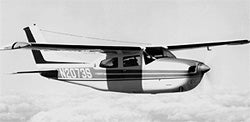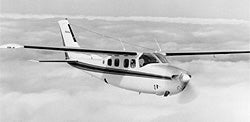CESSNA 210 “CENTURION”
Built from 1960 to 1986, the single-engine retract design still cuts a classic figure on the ramp.
 Cessna Turbo Centurion II STANDARD DATA: (Centurion) Seats 4-6. Gross wt. 3,800. Empty wt. 2,133. Fuel capacity 90. Engine 300-hp Teledyne Continental (at takeoff). STANDARD DATA: (Turbo) Seats 4-6. Gross wt. 4,000. Empty wt. 2,221. Fuel capacity 90. Engine 310-hp turbocharged Teledyne Continental (at takeoff). |  Cessna Pressurized Centurion STANDARD DATA: (Pressurized) Seats 4-6. Gross wt. 4,000. Empty wt. 2,340. Fuel capacity 90. Engine 310-hp turbocharged Continental at takeoff). STANDARD DATA: (Early 210) Seats 4. Gross wt. 2,900. Empty wt. 1,735. Fuel capacity 84. Engine 260-hp Continental. |
Until the introduction of the Cardinal RG in 1971, the Cessna 210 Centurion was the only single-engine, high-wing, retractable gear airplane manufactured by the largest maker of light aircraft. The Centurion was introduced in 1960, and the early versions had a top speed of about 195 mph. A gain in horsepower to 185 increased the top speed by five mph, but it was not until 1966, when a turbocharged engine was made available, and 1967, when the strutless wing was installed, that the Centurion became a truly high-speed aircraft. Service ceiling with the turbocharged engine is high enough to get over most weather problems. The maximum takeoff and landing weight had been increased to 3,800 pounds, with almost half of that in useful load. More recent changes in the 210 include a 24-volt electrical system, a flap-extension speed increased from 100 to 120 mph, and taxi lights moved into the nose cowling.
Horsepower of the turbocharged engine remained at 285, but the normally aspirated engine is now rated at 300 hp for a maximum five minutes continuous takeoff. Like other Cessna models employing the turbocharged version of the basic 285-hp Continental, the Turbo Centurion makes use of 310 hp on takeoff. Overall, the 1977 T210 climbs and cruises faster and more efficiently than its 1976 counterpart. Maximum cruise speed is up by approximately six mph at altitudes between 10,000 and 20,000 feet. Also, the reduction in takeoff distance is a significant 130 feet less than before. Other refinements included power switch/circuit breakers, simplified wiring, improved ventilation, and a redesigned vernier mixture control. In 1978, Cessna introduced the world's first pressurized single-engine aircraft, the Pressurized Centurion with standard seating for six, the economy of up to 77 seat-miles per gallon, and a payload of more than 1,100 pounds with full fuel. The pressurized differential provides a 12,000-foot cabin at 23,000 feet. A special high-capacity turbocharger on the Continental powerplant supports the pressurization system.
Improvements for 1979 included elimination of the main landing gear doors to decrease the empty weight of the aircraft by 25 pounds, dropping gear-retraction time to less than eight seconds, and simplifying maintenance. For the Turbo Centurion, takeoff weight was increased by 200 pounds to 4,000 pounds so that it now equaled the figures for the pressurized model. In 1980, air conditioning and deice became an option for all Centurion models. Newer standard features were an improved avionics cooling system and an anti-precipitation antenna.
Though many believed that the pressurized Centurion had evolved into a nearly perfect high altitude single, the model was shelved when Cessna ceased all single engine production after the 1986 model year and has never reappeared.

Subscribe to Our Newsletter
Get the latest Plane & Pilot Magazine stories delivered directly to your inbox





